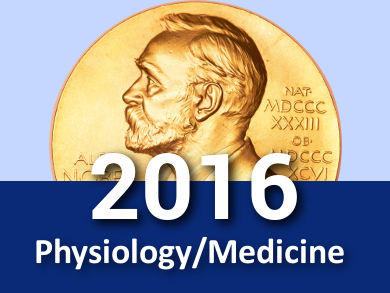The Nobel Prize in Physiology or Medicine for 2016 has been awarded to Yoshinori Ohsumi, Tokyo Institute of Technology, Tokyo, Japan, “for his discoveries of mechanisms for autophagy”. Autophagy is a fundamental process for degrading and recycling cellular components; an important mechanism to keep the body healthy. Ohsumi’s discoveries led to a new understanding of how the cell recycles its content. The Nobel Prize Committee said that “the work of Ohsumi has dramatically changed the understanding of this vital process”.
Yoshinori Ohsumi focused on protein degradation in the vacuole since 1988. In 1992, he published his so-called major break-through experiment in which he proved that authophagy exists in yeast cells [1]. Yeast cells are often used as a model for human cells, but they are small and their inner structures not easily distinguished under the microscope. Ohsumi’s experiments opened the way to identify and characterize key genes involved in the process of authophagy. In 1993, he published a work on 15 genes that control authophagy processes [2].
Yoshinori Ohsumi, born 1945 in Fukuoka, Japan, received a B.Sci. in 1967 and a D.Sci. in 1974, both from Tokyo University, Japan. From 1974–1977, he was a postdoctoral fellow at the Rockefeller University in New York City, USA. In 1977, he became a Research Associate at The University of Tokyo, in 1986 a Lecturer, and in 1988 an Associate Professor. In 1996, he moved to the National Institute for Basic Biology in Okazaki City, Japan, where he was appointed Professor. From 2004–2009, Ohsumi was also professor at the Graduate University for Advanced Studies in Hayama, Japan. In 2009, he was Emeritus Professor at the National Institute for Basic Biology and at the Graduate University for Advanced Studies, Japan, and a Professorship at the Tokyo Institute of Technology.
Ohsumi received numerous prizes and awards, including the Japan Academy Prize from the Japan Academy in 2006, the Gairdner Foundation International Award in 2015, the International Prize for Biology in 2015, the Rosenstiel Award 2015, and the Wiley Prize in Biomedical Sciences in 2016. This is the sixth time someone has gone on to win a Nobel Prize after winning the Wiley Foundation prize.
Selected Papers
- K. Takeshige, M. Baba, S. Tsuboi, T. Noda, Y. Ohsumi, Autophagy in yeast demonstrated with proteinase-deficient mutants and conditions for its induction, J. Cell Biolog. 1992, 119, 301–311. DOI: 10.1083/jcb.119.2.301
- M. Tsukada, Y. Ohsumi, Isolation and characterization of autophagy-defective mutants of Saccharomyces cerevisiae, FEBS letters 1993, 333 (1-2), 169–74. DOI: 10.1016/0014-5793(93)80398-E
- N. Mizushima, T. Noda, T. Yoshimori, Y. Tanaka, T. Ishii, M. D. George, D. J. Klionsky, M. Ohsumi, Y. Ohsumi, Y, A protein conjugation system essential for autophagy, Nature 1998, 395 (6700), 395–8. DOI: 10.1038/26506
- Y. Kabeya, N. Mizushima, Y. Ueno, A. Yamamoto, T. Kirisako, T. Noda, E. Kominami, Y. Ohsumi, T. Yoshimori, T, LC3, a mammalian homologue of yeast Apg8p, is localized in autophagosome membranes after processing, The EMBO J. 2000, 19 (21), 5720–5728. DOI: 10.1093/emboj/19.21.5720
- Y. Ichimura, T. Kirisako, T. Takao, Y. Satomi, Y. Shimonishi, N. Ishihara, N. Mizushima, I. Tanida, E. Kominami, M. Ohsumi, T. Noda, Y. Ohsumi, A ubiquitin-like system mediates protein lipidation, Nature 2000, 408, 488-492. DOI: 10.1038/35044114
- R. John Mayer, Aaron J. Ciechanover, Martin Rechsteiner, Yoshinori Ohsumi, Molecular Dissection of Autophagy in the Yeast Saccharomyces cerevisiae in Protein Degradation: The Ubiquitin-Proteasome System, Volume 2, 2008. DOI: 10.1002/9783527620210.ch2
Also of Interest
- The Nobel Prize,
Veronika Belusa,
ChemViews Mag. 2015.
Collection of information on the Nobel Prize - Nobel Prize in Physics 2016
Thouless, Haldane, Kosterlitz awarded for theoretical discoveries of topological phase transitions and phases of matter




